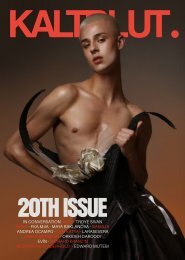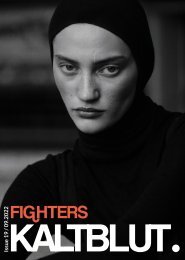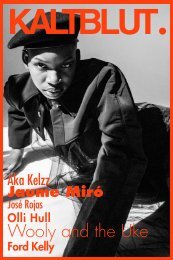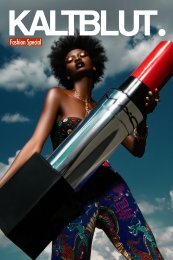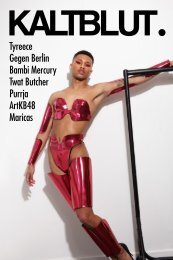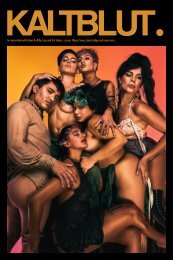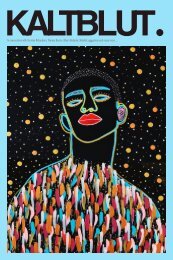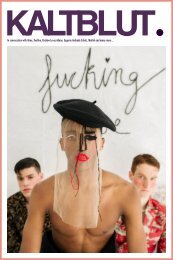Issue 21 – In Conversation with .. 10!
Welcome to the 21st issue of KALTBLUT. In conversation with Daniel Zillmann, YuYu, ALLIE X, Joseph W. Ohlert, Kid Simius, Emilio, Branko Popovic, Tariq Alsaadi, BEC, Dennis Grigorev, Hümeyra Demircioğlu, BKLAVA, Anita Vieiro and SISSY MISFIT. 404 pages filled with art, fashion and music.
Welcome to the 21st issue of KALTBLUT. In conversation with Daniel Zillmann, YuYu, ALLIE X, Joseph W. Ohlert, Kid Simius, Emilio, Branko Popovic, Tariq Alsaadi, BEC, Dennis Grigorev, Hümeyra Demircioğlu, BKLAVA, Anita Vieiro and SISSY MISFIT. 404 pages filled with art, fashion and music.
Create successful ePaper yourself
Turn your PDF publications into a flip-book with our unique Google optimized e-Paper software.
Now my process of creation is less<br />
about deconstructing the old and more<br />
about re-constructing its narrative to<br />
reflect contemporary issues of our<br />
society. Drawing inspiration from my own<br />
experiences as a Queer Asian navigating<br />
life in the West, I attempt to unravel<br />
unspoken social norms and values,<br />
challenging the very essence of Western<br />
definitions of culture.<br />
As an artist deeply involved in Web3,<br />
how do you believe blockchain technology<br />
is reshaping the art landscape, especially<br />
for digital creators?<br />
Blockchain is such a fascinating and<br />
multifaceted technology. The digital art<br />
side of it is only a tiny fraction of all the<br />
applications it enables. Regardless, and<br />
even though following the turbulence of<br />
2022 the on-chain art market is facing<br />
challenges, I am a strong admirer of<br />
the ethos it entails. For many creators,<br />
especially digital natives, the traditional<br />
art canon has been an exclusive and<br />
highly<br />
alienating industry. With the advent<br />
of Web3 and NFTs in 2020 and 20<strong>21</strong><br />
we experienced, as people tend to call,<br />
a ‘democratization’ of the industry.<br />
I don’t find this term exact. Web3<br />
remains heavily attached to Web2<br />
platforms and practices. Large social<br />
media followings reflect good sales,<br />
pushing creators into an endless act<br />
of balancing between developing their<br />
visions and feeding what the algorithms<br />
want. It might have allowed a rise in<br />
direct relationships between collectors<br />
and creators but that is not too different<br />
from what social media marketing and<br />
influencers did to traditional marketing<br />
a decade ago. The ways of<br />
communication are changing rapidly<br />
and we see adjustments in almost every<br />
facet of society.<br />
Where blockchain becomes particularly<br />
interesting in terms of digital art, is<br />
that it provides the foundation for<br />
digital ownership, a concept that has<br />
long existed but was impossible to<br />
implement. Through encryption and<br />
the blockchain, digital assets provide<br />
a unique, verifiable, and immutable<br />
record of ownership, granting individuals<br />
unprecedented control and freedom over<br />
their digital possessions.<br />
There is a growing interest in this<br />
technology from large cultural institutions<br />
across the globe and I am sure we will<br />
witness big shifts in how audiences<br />
perceive digital art in the years to follow.<br />
What role do you feel race inclusion and<br />
gender representation play in your work,<br />
and why do you feel these themes are<br />
important to explore in today’s society?<br />
Representation and inclusion drove me<br />
to create and communicate. Their lack<br />
to be more exact. I used my work as<br />
a way to explore those terms further<br />
than the often tokenistic and superficial<br />
definitions we attribute to them. You<br />
see, in my eyes, representation and<br />
inclusion have to do <strong>with</strong> getting a seat<br />
on the table, being heard, and being<br />
able to contribute to the shaping of the<br />
society you are part of. My work is a<br />
visualization of my voice and thoughts,<br />
and through it, I can examine the societal<br />
boundaries in which I operate.<br />
Amidst a new era of populism,<br />
polarization, and capital-induced<br />
authoritarianism, civil liberties and<br />
hard-earned achievements of progress<br />
are being questioned. To put it simply,<br />
our bubble is bursting. We raise more<br />
walls than we tear down and that makes<br />
us forget all the things that bring us<br />
closer. The reason I began to create<br />
artworks has always been closely<br />
intertwined <strong>with</strong> my perception of the<br />
society I lived in, and for that reason,<br />
the conceptual commentary they entail<br />
reflects what I consider important for<br />
a more equitable future.<br />
The nude form has historically been<br />
both celebrated and stigmatized in art.<br />
How do you navigate this dichotomy in<br />
your pieces, and what message do you<br />
hope to convey?<br />
The nude form has indeed been<br />
historically such a dividing topic. It has<br />
also been extremely sided. The very vast<br />
majority of imagery created throughout<br />
the millennia of human existence<br />
has been from the perspective of the<br />
dominant gender <strong>–</strong>male. That has led to<br />
stereotypical depictions that saw men in<br />
the positions of warriors or heroes while<br />
women held passive roles as objects of<br />
admiration and sexual stimulation. Add<br />
to that the prudish teachings of religions<br />
across the globe and you get a very<br />
twisted perception of the most natural<br />
thing about us <strong>–</strong>our very form.<br />
<strong>In</strong> my work, I use the body as a vessel<br />
to carry a message. It is not nude for<br />
the sake of being nude. <strong>In</strong> most cases,<br />
it’s not even sexual. It is just a body,<br />
<strong>with</strong> any connotations that it may<br />
carry. It is interesting though to explore<br />
this dichotomy in terms of audience<br />
perception.<br />
71




